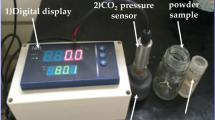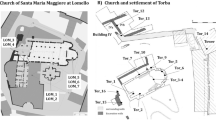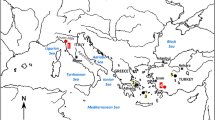Abstract
THE anthracite of the Don has been investigated by the derivatographic method of F. Paulik, J. Paulik and L. Erdey1. By this method it is possible, by a single, automatically recorded measuring process, to obtain not only the thermogravimetric curve showing the change in weight of the sample (TG in Fig. 1) but also the rate of loss of weight (DTG) and the differential thermal analysis curve (DTA), giving information on the changes in temperature during thermal decomposition. The temperature curve (T), with the assistance of a calibration curve previously photographed on the paper, gives the temperature corresponding to each point obtained.
This is a preview of subscription content, access via your institution
Access options
Subscribe to this journal
Receive 51 print issues and online access
$199.00 per year
only $3.90 per issue
Buy this article
- Purchase on Springer Link
- Instant access to full article PDF
Prices may be subject to local taxes which are calculated during checkout
Similar content being viewed by others
References
Paulik, F., Paulik, J., and Erdey, L., Z. anal. Chem., 160, 241 (1958).
Paulik, F., and Weltner, M., Acta Chim. Acad. Sci. Hung., 16, Fasc. 2, 159 (1958).
Lermusiaux, A., and Quinot, E., Chim. et Indust., Paris, 77, 517 (1957).
Author information
Authors and Affiliations
Rights and permissions
About this article
Cite this article
WELTNER, M. Derivatographic Investigation of the Anthracite of the Don. Nature 183, 1254–1256 (1959). https://doi.org/10.1038/1831254a0
Issue Date:
DOI: https://doi.org/10.1038/1831254a0
This article is cited by
-
Studies on the self-ignition of high-molecular substances at low temperatures
Journal of Thermal Analysis (1975)
Comments
By submitting a comment you agree to abide by our Terms and Community Guidelines. If you find something abusive or that does not comply with our terms or guidelines please flag it as inappropriate.



